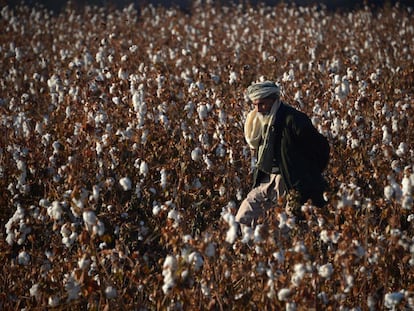The hidden backroom of Mexican coffee
An investigation conducted by the NGOs Empower and Coffee Watch has traced the origins of Nestlé and Starbucks products. The report reveals the firms’ abusive relationship with small producers, the pressures that farmers are subjected to, as well as the environmental impact of the coffee industry
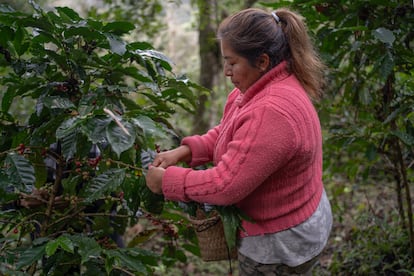

Cirio Ruiz walks through his farm and relives the moment he was arrested.
With a machete in his hand, he was removing the weeds that grow between his coffee plants and the more than 70 species he cultivates. Police vans came looking for him at the property, where you can barely get a phone signal. They intercepted him when he went over to greet them, pulling their guns on him and dragging him into a vehicle.
Ruiz was taken into custody on May 26, 2023. He spent 34 days in prison. He and four other people were accused of starting a fire at the facilities belonging to the Agroindustrias Unidas de México (AMSA), a trading company, while they were protesting for fair prices in the purchase of coffee. The courts eventually acquitted them, although the company continues to appeal. “43 years of struggle! Always peaceful, civil, union protests. With the calculator as a weapon,” the coffee farmer and activist chuckles.
Ruiz’s story illustrates one of the problems — that of pressure from above — in the long list of obstacles faced by small coffee producers in Mexico. An investigation by Empower, an organization dedicated to corporate research, in alliance with Coffee Watch recently traced the origins of Nestlé and Starbucks products. The report portrays the hidden backroom of the Mexican coffee sector, where abuses against small producers take place, poor practices with enormous environmental impact spread and economic interests become intertwined with political power.
In the middle of all of this is the bean — golden, with cinnamon hues — which, each year, makes its way into a market that cannot meet the level of global demand. In this competitive sector, Mexico has consolidated itself among the countries that contribute the most beans: according to the United States Department of Agriculture, it’s in 10th place.
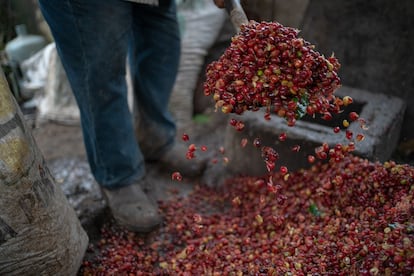
The harvest was delayed by two months this winter and began in January. “Who knows why,” some coffee producers in Coatepec shrug. They hope that, if this year is better than last winter, more than a million tons of coffee cherries (as the fruit that surrounds the bean is called) will leave the center and south of the country. Most of this production ends up in the hands of intermediaries, be they smugglers or marketing companies. They, in turn, resell a continuous flow of this bean to large conglomerates, such as Nestlé or Starbucks. The companies that are in charge of this process, such as AMSA, have been accused by farmers of monopolistic practices, an accusation that the firms deny. But the truth is that, for years, they’ve become almost the only option that farm owners have to put their coffee on the market.
Political cronyism
This past January — just as it did at the beginning of Andrés Manuel López Obrador’s six-year term (2018-2024) — Nestlé announced an investment of $1 billion in Mexico, spread out over the course of President Claudia Sheinbaum’s administration (2024-2030). During the previous administration, such a sum didn’t simply establish strong ties with the executive branch of government: it also served to expand Nestlé‘s operations with ease. In July of 2022, the Swiss multinational, alongside the president, inaugurated a new Nescafé plant in the eastern state of Veracruz. According to what was announced in a statement, this turned Mexico into the firm’s largest supplier of coffee beans, surpassing Brazil and Vietnam, the two countries that produce the most coffee in the world.
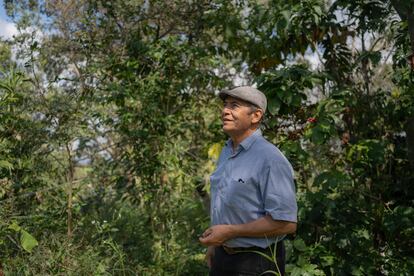
“There was a double game. One was to make an alliance with the small-scale producers — the Indigenous [groups] — but [Nestlé] also made a very clear alliance with the coffee companies,” Ruiz notes, recapping what the coffee situation was like during the last six-year presidential term. “How do they make things easy for themselves in Veracruz, a bastion of [the ex-president’s party]? Well, they have [so many connections] that the company can levy accusations to the point that they put five of us in jail out of revenge.” The case of the producers arrested in Veracruz spread throughout the country in 2023. This put coffee organizations and cooperatives in other states on high alert: they were also fighting against the low prices being offered by buyers.
The problem began in January of 2022. The coffee growers of the municipality of Ixhuatlán, about 60 miles from Xalapa, the capital of the state of Veracruz, blocked the doors of the AMSA processing plant, in rejection of a surprise drop in prices being paid out for beans. The tensions escalated to the point that some of the company’s offices were set on fire. In response, the firm sued the coffee growers for damages. For more than a year, however, this lawsuit came to nothing, until May 2023, when agents from the Veracruz Attorney General’s Office arrested Ruiz and four colleagues for alleged “damages.”
From the perspective of the farmers, the case filed against them had the complicity of the state authorities, because the coffee-processing industries represent a bastion in the local economy. In 2021, the economic impact that this product had in the state was 1.3 billion pesos ($64 million), according to data from the federal government. Queried by EL PAÍS, one of the directors of AMSA declined to make a statement.
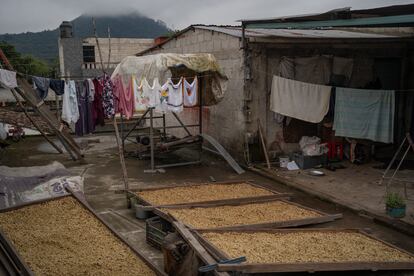
The Empower investigation refers to the complicity between politicians and businesspeople, which indicates that there are also economic contributions from — and agreements with — executives. Two Nestlé subsidiaries alone have “30 agreements and 540 public contracts with at least 33 [departments]” from the public administration. “Thanks to these agreements, Nestlé has continued to build its space of influence in the public sector in Mexico, setting guidelines in research, education and food production, as well as in public health and nutrition in the country,” the report states.
Behind a cup of Nestlé or Starbucks
The investigation, which is based on interviews, academic documents and customs reports, points to the marketing companies as the origin of labor exploitation. The report paints a picture of a production process undertaken by people with few resources, often Indigenous families, who plant and harvest the crop on smallholdings. They ultimately obtain earnings that are equivalent to a small percentage of the price of the final product.
“Coffee prices are set on the New York and London stock exchanges and — based on them — trading companies define the purchase price, [also basing it] on variables such as the region, the type and quality of the coffee and the certifications held by the producer,” the document states. “Coffee prices in Mexico are largely determined by its final buyers, among which Nestlé, which purchases approximately 25% of Mexican coffee, and Starbucks stand out.”
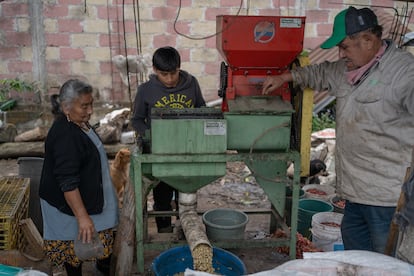
The two transnationals don’t buy directly from Mexican producers. Instead, the report points out, they go through intermediaries: ECOM Agroindustrial (based in Switzerland), Neumann Kaffee Gruppe from Germany, as well as Louis Dreyfus from the Netherlands.
According to the document, Nestlé handles 24% of global production and uses it to make Nescafé, Nespresso and Dolce Gusto. And, since 2018, it also distributes Starbucks brand capsules and other products that are usually sold in supermarkets. Meanwhile, Empower points out, the chain buys Mexican coffee beans and ships them to the United States, where they are roasted and re-imported via the company Alsea. The beans used by Starbucks are also acquired through AMSA, the same trading company used by the Swiss company.
“For their business to be profitable, of course, the trading companies must keep a percentage of the value of the coffee, further reducing the price paid to farmers. In this process, [as explained by the coffee growers] coffee prices are reduced so much that, sometimes, they’re insufficient to cover even the expenses they invested in production,” the report says.
According to what the coffee producers in Mexico have told EL PAÍS, they receive an average of 18 pesos ($0.89) per kilo of coffee cherries. Some specialists calculate that about 10 kilos of these are needed to make just a kilo of roasted coffee. Meanwhile, coffee is sold in supermarkets at a high price: a package of 12 capsules containing 66 grams of coffee in total costs 177 pesos ($8.72), which raises the price per kilo to 2,681 pesos ($132.05). This calculation leaves small coffee growers with a profit that works out to just six or seven percent of the total.
Asked about the low compensation received by producers, Nestlé has indicated that the 2024-2025 cycle has been “historically the highest” that they’ve paid to their direct suppliers in Mexico. They assure EL PAÍS that they “firmly” believe that “coffee growers should earn a sufficient income to maintain a decent standard of living.”
“All of our coffee operations comply with local laws and international standards. If there are indications that these standards are not being followed, we will investigate and take the necessary corrective actions,” a Nestlé representative affirmed, in a reply sent to this newspaper. Starbucks, for its part, has not responded to queries from EL PAÍS..
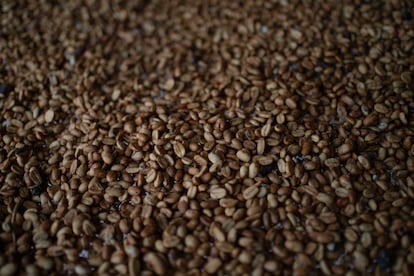
Arturo García, a producer from the southwestern Mexican state of Guerrero, says that the traders are “vultures” who are circling the coffee business. “AMSA doesn’t respect the price of [the bag’s weight]… they pay you whatever they want,” he complains in a telephone interview. The farmer recalls that, at the beginning of López Obrador’s six-year term, there was talk of reactivating the coffee sector, but “the only thing that was done was to give a subsidy of 6,000 pesos a year [to each coffee farmer].” While that amount of money, the equivalent of just under $300, was beneficial, “saying that [the sector] will be reactivated with that just isn’t true.” García maintains that the policy of the last six-year term, during which intermediaries were attacked, ended up hitting local cooperatives, while it didn’t make a dent in the activities of smugglers or hoarders. “For sales to be possible and fair, small producers have to unite. Our survival depends on self-managed organizations.”
Empower’s research adds: “The lack of collective organizing not only diminishes [producers’] bargaining power, but also increases their financial dependence [...] many are forced to resort to monetary or in-kind loans, such as fertilizers or seedlings, which are often granted by the same companies that later buy their coffee beans.”
A boost to robusta coffee
The most visible evidence of the growth of robusta coffee in Mexico are the plantations that have begun to spread throughout the country. Hectares have been cleared to plant this tree, which doesn’t exceed a height of 13 feet. This variety, unlike arabica, must be planted in full sun and, therefore, is often accompanied by deforestation to reduce shade. It’s a plant that produces a lower quality fruit that’s cheaper on the market, something that attracts large coffee producers all around the world. Some countries such as Brazil have turned to harvesting robusta, in order to sell it to large firms. But the Mexican countryside has resisted pressure to stop planting arabica, which is a more environmentally-friendly variety. For the moment, these deforested hectares remain a residual number in national production..
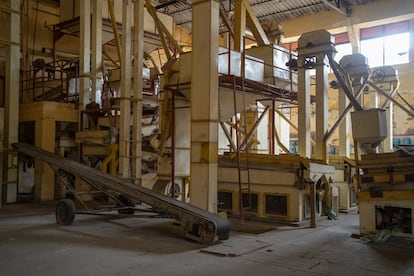
“Nestlé has encouraged us, through its intermediaries, to plant robusta. But people haven’t done it,” says García, speaking to EL PAÍS from Guerrero. The farmer explains that pressure came in the form of penalties on the price of arabica, or via technical assistance that was given to them for free if they switched to robusta. The coffee growers were also given plants through social responsibility programs and were paid a small premium on their production if it was robusta — “something insignificant” — in order to get them to abandon their standard variety and switch to the preference of the large companies. It wasn’t enough; the majority of small producers stuck with arabica.
“The ‘robustization’ of Mexican coffee — driven mainly by Nestlé and the programs operated by [monopolies] to control the production of Mexican coffee — constitutes a major threat to the environment, both due to its deforestation potential and [because of] the possible elimination of the coffee varieties traditionally cultivated in the country,” the investigation notes. The resistance that the Mexican countryside currently maintains forced Nestlé to import coffee beans from abroad, to be processed in its Mexico-based factories. According to customs records, between 2022 and 2024, the company imported some 8,129 tons of coffee from Brazil, Colombia, Honduras and Guatemala. In that same period, it only bought 1,885 tons in Mexico. The bulk of the product it brought into the country was robusta coffee. Farmers claim that the flooding of the market with this variety brought in from abroad has been another factor that has affected the price paid to arabica producers.
Regarding the controversy over robusta coffee, the company states that “the Nescafé Plan includes the promotion of the adoption of sustainable and regenerative agricultural practices, which include: crop diversification, natural soil conservation and the development of varieties that are more resilient to climate change.” The company also assures EL PAÍS that it has financed the planting of 225,000 shade trees, although it doesn’t offer details about where they’ve been planted.
However, despite all the environmental certifications and ethical commitments advertised on their products, the Mexican coffee giants hide practices that are unfair to those who work the land and to the soil itself. This is according to all the coffee growers consulted by EL PAÍS.
“With every cup of coffee you drink, you support the livelihood of coffee growers,” reads a Nescafé jar, in a Mexico City supermarket. A few inches away, on the same shelf, are dozens of Starbucks and Dolce Gusto capsules. Of each of these products, only six to seven percent of the sticker price will reach the hands of farmers.
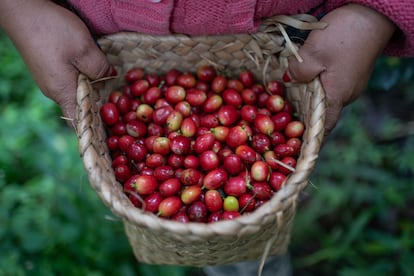
Sign up for our weekly newsletter to get more English-language news coverage from EL PAÍS USA Edition
Tu suscripción se está usando en otro dispositivo
¿Quieres añadir otro usuario a tu suscripción?
Si continúas leyendo en este dispositivo, no se podrá leer en el otro.
FlechaTu suscripción se está usando en otro dispositivo y solo puedes acceder a EL PAÍS desde un dispositivo a la vez.
Si quieres compartir tu cuenta, cambia tu suscripción a la modalidad Premium, así podrás añadir otro usuario. Cada uno accederá con su propia cuenta de email, lo que os permitirá personalizar vuestra experiencia en EL PAÍS.
¿Tienes una suscripción de empresa? Accede aquí para contratar más cuentas.
En el caso de no saber quién está usando tu cuenta, te recomendamos cambiar tu contraseña aquí.
Si decides continuar compartiendo tu cuenta, este mensaje se mostrará en tu dispositivo y en el de la otra persona que está usando tu cuenta de forma indefinida, afectando a tu experiencia de lectura. Puedes consultar aquí los términos y condiciones de la suscripción digital.

